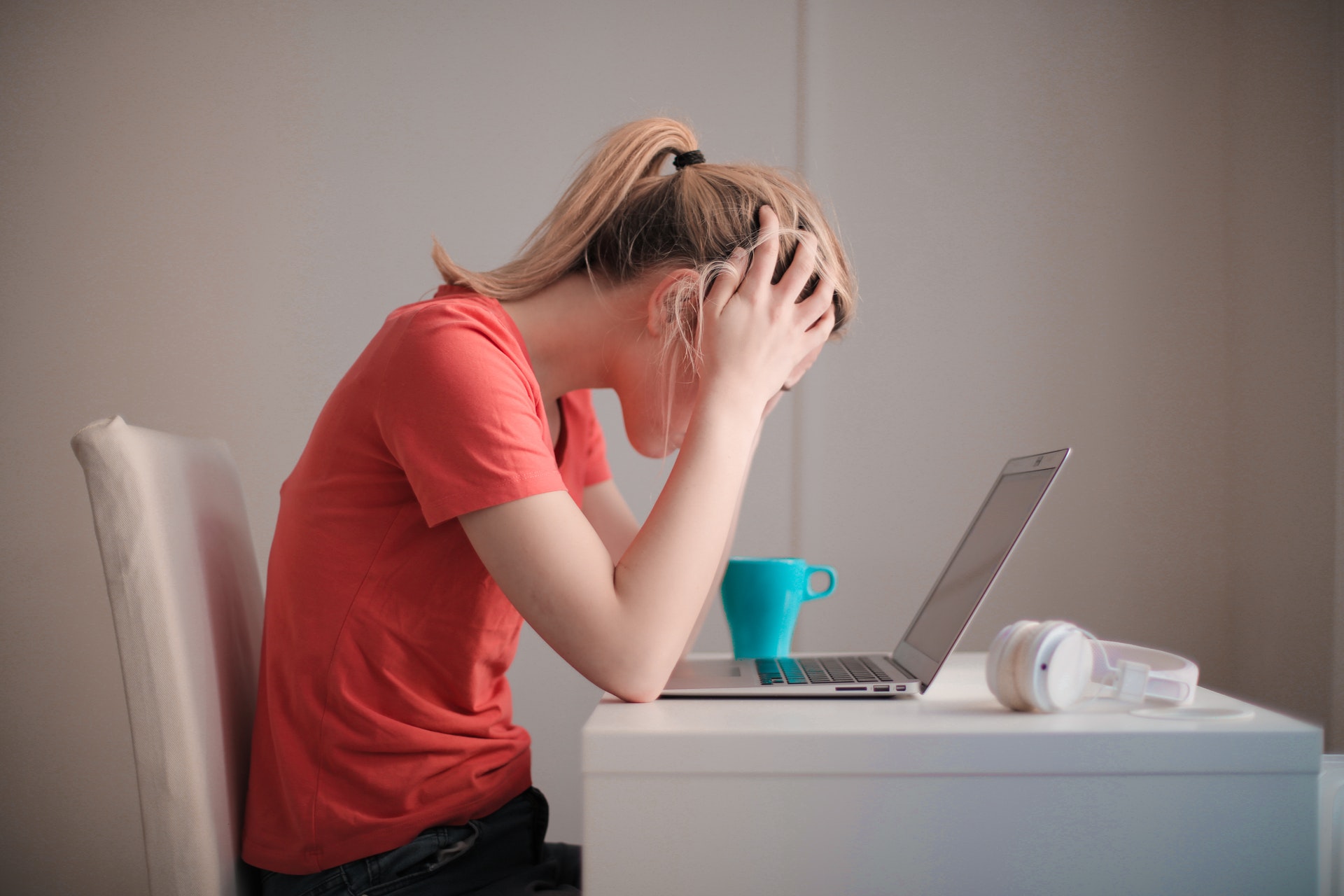[vc_row][vc_column][vc_column_text]Recent workplace stress statistics show that 83% of Americans stress over at least one work-related issue. If you’re also one of the people with a highly stressful job, the chances are that you too often find yourself thinking about how to control this tension.
The key to handling excessive stress at work is understanding its roots. For instance, one of the most frequent stressors at work lies in the extreme demands clashing with one’s insufficient abilities. For broader insight into all the challenges a contemporary worker faces and easier identification of the causes of stress in the workplace, we have looked into some of the mind-boggling statistics and facts that you might find interesting.
Top 10 Stats and Facts Reviewed:
- 18% of the workers from Europe claim they deal with stress in the workplace each day.
- 21% of the workers report that long working hours are the main cause of work-related stress.
- Women are more likely than men to overeat when dealing with work-related stress, while men are more likely to opt for drug use.
- Surprisingly enough, workers with higher incomes are more likely to experience workplace stress.
- Workplace stress facts indicate that the incapability of establishing good work-life balance is one of the leading causes of stress at work.
- 17% of healthcare employees state they are “highly stressed” due to their work.
- 80% of the remote workers claim they feel “not stressed at all” or “stressed to a moderate extent.”
- 33,3% of customer service workers report they often feel emotionally exhausted after work.
- Working mothers are 18% more stressed than childless women.
- Burnout syndrome accounts for 8% of the occupational illness cases.
Work-Related Stress around the World
1. According to workplace stress statistics from 2019, up to 55% of the US residents experience stress at work.
(Stress)
Recent research of the workers’ everyday mood indicates that more than ½ of the American workforce is exposed to stress on a daily basis, which is significantly higher than the average global percentage (35%). According to these stress stats, the US workers are approaching the Greek ones, who have had the title of the most stressed workers in the world ever since 2012, with 59%.
(ETUI)
One of the 2018 surveys has confirmed that, altogether, the percentage of people across Europe that had to deal with stress in the workplace equaled 18%, which reflects a 5% increase in comparison to the previous year’s survey examining the same subject. The survey in question studied the issue incorporating nearly 10,000 workers from several countries within Europe, including Switzerland, Italy, Netherlands, Germany, France, Poland, and the UK.
(Perkbox)
Other causes of stress in the workplace among the UK workforce are worries about the performance, which applies not only to self-performance (13%) but to the performance of others as well. For instance, there are often concerns about new employees’ productivity (14%). Other concerns include the extent of clients’ contentment (11%), and quarrels over office rules and politics (9%).
(Japan Today)
A study conducted on the basis of answers given by 7,000 working participants in Japan has found that 40% of all the examinees sleep less than six hours a day. In men, this lack of sleep is reportedly mostly caused by work-related concerns, while women tend to lose their sleep over video games and smartphones, with the exception of working mothers, who usually experience lack of sleep simply because of the everyday parenthood challenges.
Workplace Stress Facts and Stats among Different Social Groups
5. Higher incomes can mean more stress over work.
(CNBC)
The examination of 1,000 LinkedIn users within the US has resulted in the conclusion that those earning between $51,000 and $75,000 experience the lowest level of stress. By comparison, nearly 70% of those earning $200,000 per month or more reported being stressed all the time. Some of the people with high incomes admit that the reason for getting susceptible to stress is greed growing along with the income, which in the end results in feeling psychologically drained and, therefore, unable to meet one’s own expectations.
6. Women and men deal with extreme stress at work differently.
(ADAA)
As per statistics, when dealing with workplace stress, women are more likely than men to overeat (46% of the questioned women vs. 27% of the men). Furthermore, 44% of women would talk to friends and relatives about the stressful situation, as compared to 21% of men. On the other hand, men seem to have found their way of coping as well – when stressing over work, they tend to have sex more frequently than they would otherwise (19% of men vs.10% of women who would act likewise) as well as engage in drug use (12% vs. only 2% of women).
7. Healthcare employees mark the largest number of workplace stress complaints.
(Fierce Healthcare)
As reported by stress in the workplace statistics, up to 69% of the surveyed healthcare employees have agreed they currently feel under pressure at their workplace. Moreover, 17% describe their stress level as high, which is not negligible either.
8. The burnout syndrome is frequently seen in medical staff.
(Science Direct)
The burnout syndrome (manifesting as a series of symptoms related to the accumulated exhaustion at work) among healthcare workers has reached 75% in some of the medical specialties. Therefore, we can say that burnout has become an occupational illness of the medical workers, for obvious reasons – immense workload, patient treatment unpredictability, and frequent exposure to death and suffering, which often results in intense emotional response.
9. Workplace stress statistics show that working mothers are 18% more stressed than the rest of the workers.
(The Guardian)
Also, did you know that the figures tend to climb up to 40% for the mothers of two? According to a research conducted by the Institute for Social and Economic Research of the Essex University, based on the data obtained from over 6,000 examinees, the key reasons that parents of young children deal with workplace stress are rigidity of the demands, and endless working hours, both of which prevent the parents from achieving the desired work-family balance.
10. Customer service representatives report feeling miserable for at least 20 minutes per hour of their working time.
(Quantum Workplace)
Customer service roles apparently aren’t the most fulfilling ones – at least that is what the stress in the workplace stats imply. The cause of stress and eventual burnout in the customer service field is most likely the combination of the two omnipresent stressors: the routine of processing mostly identical requests repeatedly all day long and having to deal with customers’ frustrations without ever opposing them.
11. Workers from home are the most likely ones to be stress-free.
(Flex Jobs)
A recent research based on a sample of 1,000 remote workers has revealed that an average home-based worker is up to 57% more likely to feel job satisfaction, compared to the average American office-based worker. Moreover, approximately 80% of examinees have characterized their usual stress level during the workweek as “not stressed” to “moderately stressed.”
Workplace Stress Facts: Identifying the Underlying Triggers
Feeling anxious about having to go to work again? The chances are that you’re aware of why you feel that way, but think again – your tedious manager or high-strung co-workers might not be the only reasons, though they could be the most obvious ones to you. There are multiple stressors you may have never even considered as potential roots of your tension at work, and we have picked the most frequent ones.
12. The incapability of establishing a good work-life balance is one of the leading causes of stress in the work environment.
(Tiny Pulse)
One of the hardest things to achieve if you’re working full-time is a healthy balance between work and everything outside of it – physical activity, social life, entertainment, basic needs such as sleep… It all requires time and is essential for workers’ consistent good performance. It seems that despite being practical, technology has intensified the issue. For example, how many times have you nervously checked your email as soon as you got home from work? If your answer is “too many,” you might be letting your work infiltrate your personal life more than you should.
13. Many workers feel as if they’re being overburdened by the amount of work.
(Tiny Pulse)
Stress in the work environment in terms of feeling unable to finish all your tasks on time is ultimately frustrating, because it makes one question their job stability, constantly stressing over getting fired. If you are sure that the task distribution at your workplace is not balanced, and you’re constantly being given more demanding tasks than your co-workers, either in terms of quantity or complexity, you should let your manager know that you need some kind of stress relief at the workplace – perhaps they’re not even aware of it.
14. Apart from work overload, it’s also the “underload” that imposes stress on workers.
(Harish Saras)
Compared to the previously described feeling of pressure as a result of too many complex tasks to cope with, work underload is what we’d call quite the opposite. While having fewer tasks to perform at work might not result in the same type of tension as having too many tasks, it can lead to overthinking and questioning one’s capacity. You might feel that your skillset is high above what your manager thinks of it, which can eventually negatively impact your self-confidence.
15. Sometimes, managers cause stress in the workplace.
(Harish Saras)
We all know someone who is a control freak, but it doesn’t affect us until we get to spend a bit more time with that person. This can be difficult to cope with even when the “disciplinarian” in question is your friend or acquaintance, but imagine having a superior with an autocratic managerial style. Or do you not have to imagine it at all? If you have a boss whose methods include restricting the freedom of the workers, especially in terms of everyday organization and decisions that concern the entire team, it is completely justified that you are getting more and more stressed out over showing up at work each day.
FAQ
How exercises reduce stress in the workplace?
Physical activity has been proven to regulate the release of stress hormones (cortisol, adrenaline, etc.) and renew your energy, which can undoubtedly increase your work performance and bring relief from work anxiety. Apart from regulating the production of stress hormones, exercise also stimulates the production of the body’s natural mood enhancers – endorphins.
What is workplace stress?
Canadian Mental Health Association has provided quite a comprehensive definition of stress, emphasizing that stress is related to our response to the situation, which is actually about ourselves rather than the situation itself. Taking this into account, we can define work-related stress as a negative psychological response triggered by a mismatch between the highly-set expectations at work and the worker’s objective power over meeting them.
According to the stats from 2018 and 2019, mental health is what deteriorates first when working in a high stress environment. Thus, 44% of illnesses of stressed workers include work related depression. These also account for approximately 54% of all working days skipped because of health issues. Moreover, mental health issues such as depression and anxiety are most frequently seen among public service workers (such as social workers, teachers, and healthcare employees).
How to handle stress at work?
Workers who feel they’re under a lot of pressure might consider informing themselves on strategies that proved to be effective in alleviating anxiety in the workplace. First of all, you need your day to start properly – with a healthy meal and having everything planned in advance. Next even though it is sometimes impossible, you should stay away from quarrels at work by avoiding sharing your personal attitude on controversial topics. Do not forget to make yourself physically comfortable as well – sore back can bring about psychological discomfort, too. Finally, remember that it is okay if you’re not a natural-born multitasker and prefer to prioritize your tasks instead of working on all of them simultaneously.
How does stress affect mental health?
Apart from being directly linked to depression and anxiety disorder, numerous studies have confirmed that the brain of people who suffer from stress-induced mental disorders can even exhibit physical differences in the structure, as compared to the brain of those who are usually stress-free. For instance, the amount of the brain’s white matter, as compared to the amount of gray matter, is higher for the first group than for the second.
How many employees are stressed at work?
Every employee in the world has experienced stress at work at least once. The figures vary across different regions, but Greece remains the number one country among the most stressed ones (59% state they face work stress and anxiety each day).
Conclusion
Most of us are accustomed to stress at work. Still, not being surprised by uncomfortable situations does not mean remaining completely unaffected by them. In the long run, being emotionally affected by tension related to your work environment is partially a good thing, implying that you’re a responsible and dedicated worker. However, there are certain boundaries one should set so that it doesn’t become overwhelming. Constant workplace stress can have detrimental effects on one’s health and professional performance. The above-listed workplace stress statistics will hopefully help you identify the origin of your work-associated stress and find a method of relaxation that works for you.
Sources:
- ADAA
- CCHOS
- ETUI
- Fierce Healthcare
- Flex Jobs
- Harish Saras
- Health Harvard
- HSE
- Japan Today
- Perk Box
- Psych Central
- Science Direct
- Stress
- The Guardian
- Tiny Pulse
- Very Well Mind
[/vc_column_text][/vc_column][/vc_row]



